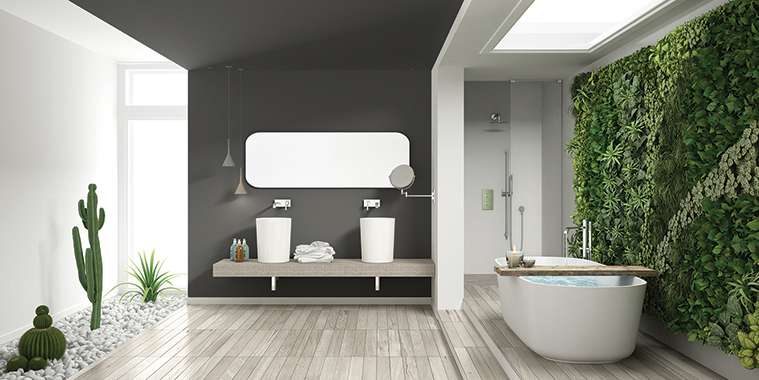Homeowners have continued to find new, dynamic forms of luxury over the course of the pandemic, seeking out things like yard space, the comforts of a warm fire (indoors and out), the newfound glam of the suburbs and more.
However, as materials shortages and supply chain issues — as well as backed up demand for home renovation projects — persisted during quarantine, luxury homeowners were hampered in just how much they could do to change their living space.
As those challenges gradually lessen now, builders are gearing up for more construction projects on the horizon. And as they do so, luxury homebuyers will be ready to make their dream homes reality. Inman spoke to real estate agents and developers to find out just what features will be in those dream homes.
Here’s what luxury homebuyers are already expressing an interest in, and will want most in their future luxury home for years to come.
Blurred boundaries, indoors and outdoors
Employing design concepts that use nature as a model is something Tyler Jones and his team at Blue Heron have always been excited about. But now those concepts, which blur the lines between the outdoors and indoors, are starting to gain more weighty traction and appreciation among the public.
“We really emulate nature and find different ways to speak to you and give you that sense of relaxation and calm that you can feel in an outdoor setting, but through a man-made structure,” Jones told Inman.
The design-focused development firm brings the outdoors inside (and vice versa) by heavy use of floor-to-ceiling windows, pocket doors that open to the exterior, sheltered outdoor spaces that merge to the indoors and waterways that flow from outside to the home’s interior. In addition, Blue Heron often uses stone as a core building material to make a home feel grounded in nature.
Outdoor kitchens, as well as a separate fire pit area, also continue to be very popular with luxury buyers, Judy Collins, office manager at Celia Dunn Sotheby’s International Realty, told Inman.
“It’s about creating a sanctuary,” Collins said. Rather than have just one room be a retreat, like a family room, homeowners want a cohesive “haven,” she explained, that includes “the whole picture of the house — front porch, back porch, pool, the exterior entertaining area.”
New designs within a home that seek to soften interior boundaries are also starting to gain traction among luxury buyers of new construction, Tiffany Curry, broker/owner of Berkshire Hathaway HomeServices Tiffany Curry & Co., Realtors, told Inman.
Two things Curry’s new-home buyers can’t get enough of today are framed glass dining rooms and framed glass wine rooms, essentially the typical dining rooms and climate-controlled wine rooms buyers might be used to, but instead of being enclosed by solid walls, they are enclosed within glass ones.
This allows homeowners to put what are some of the more formal or upscale features of their home on display, Curry said. Proud oenophiles with curated collections are especially excited about the latter, she added.
“I have a tech buyer that we’re shopping for, and [the home] will be custom for him,” Curry said. “He’s a wine connoisseur so he wants to see his wine collection when he first comes through the door. Most of the wine rooms are behind the dining room, but it’s a framed glass [room], you can see straight through.”
More space
As increased time at home continues to be the norm, luxury new-home buyers are still looking for more space and will demand this for the foreseeable future, industry professionals told Inman. That includes more square footage, more rooms, more outdoor space, multigenerational homes with guest houses and more.
Two home offices, a home-schooling room and extra yard space are typically requirements from buyers these days, Jones told Inman.
By the same token, Collins said that clients are requesting wider front porches to linger on, and required square footage has increased from about 3,600 in pre-COVID days to 4,800 today.
Paul Benson, license partner and global real estate advisor for Engel & Völkers, said luxury buyers are still seeking out space by shifting into resort and country markets, migration that he says “does not seem to be letting up.”
Indoors, Benson said buyers are maximizing space with more ample kitchen cabinet storage to allow for a more open, congregational space where people can watch and participate while home cooks are at work.
The concept of more space also extends to closets, Curry told Inman, which have become bona fide rooms of the house to linger in. Two-story closets are “all the rage” among her buyers building custom homes, she said.
“People are loving those. Some of them actually open to a portion of the bath. When you walk into the bathroom, you can see portions of the closet, which is amazing. It’s kind of like you’re walking into the main room of the house. It’s gorgeous.”
Seamless smart home tech
“It’s just a given now in a luxury home,” Collins told Inman of smart home tech. “It’s no longer considered an option or an upgrade … it’s just an expectation.”
Just within the last few years, Jones said that smart-home tech has vastly improved, which is probably one major reason it’s become a mainstay in new luxury homes.
“There was a point where I wasn’t even a huge advocate,” Jones said. Because “in the past, it was more complicated than it should have been.”
“[Smart home companies] have really been able to refine [tech] and simplify it to a point where it’s easy for people to understand, and it works,” he added.
Smart home features that monitor and control air quality, in particular, will see high demand for the foreseeable future as COVID-19 remains a threat.
“Systems like the Darwin Home Wellness System, which regulates the entire climate, air quality, ventilation, humidity, and even lighting to match the person, naturally, are dream items right now,” Benson said.
Energy independence
With politics, climate change and other factors leaving luxury homeowners feeling uncertain about their ability to depend upon the grid, many have taken to shoring up properties with alternative
energy solutions.
Solar panels have been a widespread offering for several years now, but high-end buyers are starting to get more serious about things like back-up batteries and generators in case of a major outage.
“The pandemic last year [was a factor], but there’s also a lot of other social factors. [It was] a turbulent year last year in a lot of ways,” Jones said. “So I think security, and just being a little more independent, has become more important to a lot of the buyers we work with.”
— Inman News



